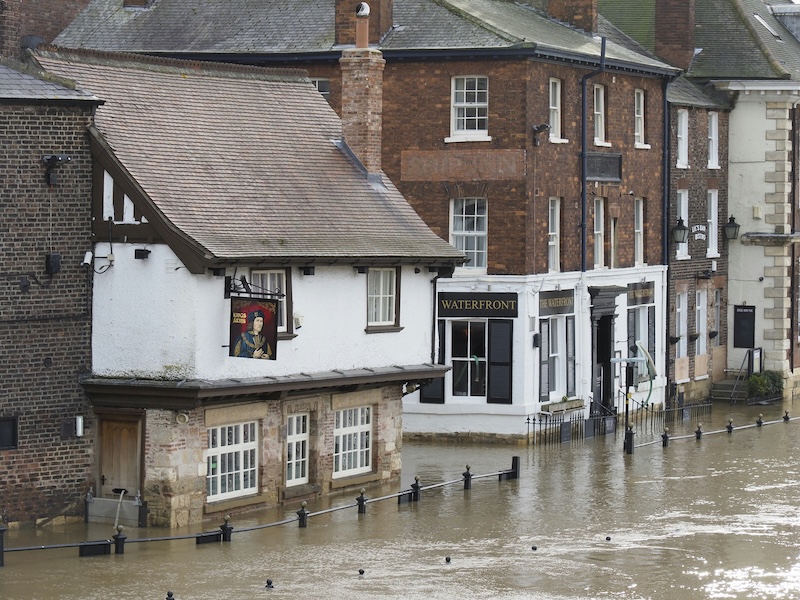Flood Insurance in the United Kingdom
Safeguarding your property from floods.

Safeguarding your property from floods.

Flood insurance can ease the financial strain that comes with flood damage, offering crucial support to homeowners and renters as they rebuild and recover.
We’ll guide you through everything you need to know to protect your property—and your belongings—from flood damage.
Flood cover protects your home and belongings against damage caused by flooding due to natural events including torrential rain and overflowing rivers or lakes.
For properties at greater risk, this cover is an essential safeguard against potentially devastating financial losses. According to the Association of British Insurers (ABI), claims related to storms and floods are a growing expense, with payouts totaling £585 million in 2024.
Yes, most home insurance policies include flood cover within standalone buildings or contents insurance policies, or within a home building insurance policy—a combination of both buildings and contents insurance. Here’s what’s covered:
| Building insurance | Contents insurance |
|---|---|
| Structural repairs for walls, floors, and foundations | Damage to furniture, carpets, and electronics |
| The cost of restoring electrical and plumbing systems | Cost of replacing personal belongings such as clothing, books, or jewellery |
| Debris removal and drying out your property | Cover for items stored in outbuildings like sheds or garages |
| Damage to permanent fixtures like built-in kitchens or bathrooms | Cover for appliances you own that are not built-in, such as a free-standing refrigerator |
It’s important to read and understand your policy to avoid unwelcome surprises when making a claim. Here are some common exclusions:
Flooding isn’t limited to properties beside rivers or the sea. Anywhere in the UK can be impacted by heavy rains or groundwater. Recent climate data from the National Flood Risk Assessment shows that 6.3 million properties are currently at risk of flooding from rivers, seas, or surface water.
Wondering whether your property has a high risk of flood damage? Use these online tools to help you assess your property’s vulnerability by postcode and review current and historical flood warnings.
Check your flood risk in:
The cost depends on factors like the location of your property, your proximity to water sources, the flood history of your property, and any measures you’ve taken to reduce flood risks. At Lemonade, contents insurance policies start at just £4 per month, and home building insurance policies start at £14 per month, covering flood damage—and so much more.
Homes in high flood-risk areas might naturally face higher premiums. Yet, initiatives like Flood Re strive to ensure that insurance remains affordable, even for those living in high-risk flood areas.
Flood Re is a reinsurance scheme introduced by the UK government and supported by insurance companies to make flood cover more accessible. If your home is eligible, Flood Re limits premium hikes and caps excess payments for flood claims (currently set at £250).
Check your eligibility here.
Insurance offers crucial financial protection, and while you can’t control when heavy rain might flood your property, you can take proactive steps to minimize flood damage. Here’s how to better protect your property:
If the worst occurs, follow these steps to handle the aftermath of a flood and maximise your insurance claim:
For ongoing support, The National Flood Forum offers practical guidance and advocacy for those affected by flooding.
Flood insurance is more than a financial safety net; it’s peace of mind in a world of unpredictable weather. Whether you reside along the coast, near a river, or even higher-up regions in England, Wales, or Scotland, it’s always better to be prepared than to face the devastating financial impacts of flooding without protection.
Explore how Lemonade can protect your home from floods today.
Tenants should consider contents insurance with flood cover to protect their belongings from water damage. This ensures they can replace personal items like furniture, electronics, and clothing after a flood.
However, tenants are not responsible for insuring the building’s structure; this is the landlord’s obligation.
When insurers talk about floods, they’re usually referring to water from natural sources like heavy rain, overflowing rivers, or the sea spilling onto dry land.
No, water from a burst pipe is not classified as a flood. Insurers typically refer to this as an ‘escape of water’ and it falls under a different section of your home insurance policy.
Yes, you can still get this cover even if your property has a history of flooding. However, premiums may be higher, and some insurers could impose conditions on cover.
Flood Re may help make insurance more affordable for eligible properties with a history of flooding.
No, flood insurance for properties doesn’t cover flood damage to vehicles—you’ll need comprehensive car insurance. It’s worth checking with your auto insurer to make sure that flood cover is included.
Groundwater flooding happens when the water table rises above the surface, usually after long periods of heavy rain. This can lead to water sneaking into basements, foundations, and other low-lying spots. It’s more common in areas with permeable soil and can stick around for a while since groundwater drains fairly slowly.
Please note: Lemonade articles and other editorial content are meant for educational purposes only, and should not be relied upon instead of professional legal, insurance or financial advice. The content of these educational articles does not alter the terms, conditions, exclusions, or limitations of policies issued by Lemonade, which differ according to your state of residence. While we regularly review previously published content to ensure it is accurate and up-to-date, there may be instances in which legal conditions or policy details have changed since publication. Any hypothetical examples used in Lemonade editorial content are purely expositional. Hypothetical examples do not alter or bind Lemonade to any application of your insurance policy to the particular facts and circumstances of any actual claim.